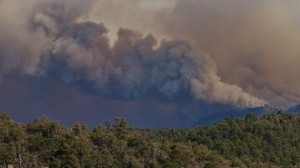
Horseshoe Two Fire, Chiricahuas
Hot winds batter the landscape, sucking whatever moisture they can coax from desiccated plants. Record-breaking temperatures challenge the survival skills of wildlife, as they and we wait for the merciful monsoonal rains, should they come in a month. We wait and watch, knowing that the first plume of smoke to rise skyward could create a blazing inferno defying our feeble but expensive efforts to limit the damage.
Arizona has endured droughts and heat waves before, but there are strong signs that human activities are exacerbating the challenges faced by the more-than-human world. The summer of 2011 saw huge tracts of forest burn up in the Southwest. I witnessed the dramatic Horseshoe Two Fire in the Chiricahuas, but in a summer of exceptional fires in both Arizona and New Mexico, that one was just the tip of the melting iceberg. That was the summer of the Wallow Fire in Arizona (largest in history), the Conchos Fire in New Mexico (also the largest recorded there), the Monument Fire in the Huachucas (which consumed the home and irreplaceable insect collections of one of my friends), and many fires in northern Mexico, where suppression was not even attempted. More than 2.1 million acres burned, over twice the previous record set in 2006 for these two states. Megafires. Unprecedented. Shocking.
My journals captured my feelings at the time, and now two years later, it’s time to revisit and reflect on what I saw.
June 2, 2011. I am driving toward the Chiricahuas after visiting friends not far from the Dos Cabezas, each of these ranges within the archipelago of “sky islands” of the Southwest. It’s 95 degrees with gale-force winds. This morning, smoke plumes indicated two concentrations of fire reflecting both natural spread and backfires set intentionally to contain the beast. Now the terrific winds have taken control; from a human perspective, the fire is completely out of control. Growing billows of smoke, white on top like mounds of creamy mashed potatoes but dingy below, lean strongly to the northeast, perhaps extending fifty miles. The San Simon Valley is dark from the intense shadow cast by the slanting pillars of smoke. Residents may feel like they are experiencing the wrath of Mordor.
I enter the Chiricahua National Monument, drive to a viewpoint, and then hike up to the Sugarloaf fire lookout at 7310 feet. As I come out of the north-face shelter to stand on the summit, my hat attempts to fly to Utah. Flames hundreds of feet high roar up over Saulsbury Saddle and toward the Barfoot Peak lookout tower. Though it is wrapped in inflammable casing, the heat is too much, and the tower suddenly glows bright orange as it’s consumed within its wrapper. The Forest Service woman on duty in the Sugarloaf Tower sheds tears; she had nearly been assigned to be in the Barfoot tower two days ago, and though she is relieved not to be there, she openly mourns the historic tower that she loved.
She told me she had mentioned to another agency fellow, “I wish it were over,” and he had said, “”Oh no, let it all burn. This is the best thing that could ever happen to this forest.” She said, “That black ground is a forest?” The Forest Service man was from Montana. He declared, “You guys have been suppressing fire all these years. Now it’s time to burn it.”
And burn it did. The monument was evacuated the next day; between the expanding fire and backfires, nearly all of it burned, as did essentially all of the high country of the Chiricahuas.
The Forest Service paradigm has changed, and like a swinging pendulum, it has gone to an opposite extreme. From “fire is bad and stop it at all costs,” the mantra has shifted to “fire is good, so let it go.” Only they weren’t letting it go. They were fighting it vigorously, using backfires to try to keep it away from structures, thus adding more acres to the burned landscape. Who knows—without the set back-burns, it could have been worse. Still, the firefighters burned more land than the initial fire did. In the end, the fire was controlled when it ran out of fuel.
There was little left to burn. Though there were certainly a few places missed, and some acreage experienced low-intensity burn, yielding hope for eventual forest recovery, much of the fire was hot, destroying the trees and perhaps sterilizing the soil. The entire landscape has changed; forest species are expected to decline (perhaps good-bye to Arizona’s only population of Mexican Chickadees). I wondered about the montane rattlesnakes. If deep in the ground, they might have survived, but what would they eat when they emerged? Would they be picked off by aerial predators when there was no cover to hide them? Might some Sky Island specialties disappear forever?
For years, the managing agencies couldn’t see the forest for the trees. Now, perhaps, they don’t see the trees for the forest. Engelmann Spruce, Douglas-fir, White Fir, Apache Pine, Arizona Madrone–Picea, Pseudotsuga, Abies, Pinus, Arbutus. Individual trees, specific epithets, up in flames, bursting like popcorn. With them go structure, shade, food resources, cover. With them go the countless organisms living in the bark or among the leaves or on the trunks, mosses and lichens gone along with their support systems. The snake writhing in the flames, its body bursting as it boils internally. The woodpecker nestlings trapped in the conifer trunks that release to the waiting atmosphere in minutes the water and carbon dioxide they accumulated over decades. The hopeful seeds lying in the shallow soils, their genetic information now gone with the wind and ash. The native fishes and aquatic macroinvertebrates in the tiny creeks, vulnerable to the floods of ash and debris that will come raging down off the denuded hills when monsoon thunderheads deliver their aqueous loads in sudden bursts.
Oh, I don’t mean to be overly sentimental. I am an ecologist, and I understand and value the ecological processes of disturbance and renewal. I understand there may be a forest again on those ridges, though not in my lifetime. I can mentally embrace the butterflies that will thrive in the understory as pioneer plants colonize the open spaces, the songbirds and mice that will proliferate in early successional stages. It’s now a different ecosystem, yet one with potential to change over time—maturing in some sense—unless another disturbance knocks it back again. There is beauty in the process of recovery.
But it’s also entirely human to mourn the death of something or someone familiar and loved. This mountain is now a bit of a stranger; the old trails I followed, the vistas I absorbed, even the soil that I felt and tasted in those rare mountain meadows is gone. My friend Narca, who lives at the foot of the Chiricahuas and who followed the progress of the blaze through her fascinating blog, wrote “I am hearing from friends who are heartbroken.”
Yes, there is relief when houses are saved, when no one is hurt, and there is sorrow when the worst occurs to humans and their possessions. But the values of the world should not be solely measured in human terms. There are thousands of other species that live in these mountains. There are many thousands of ecological relationships terminated or altered in the conflagration. Let us not forget to acknowledge the losses even as we celebrate the resilience of nature.
The new mountain will be different. And so are we.
I guess that the forester with his glib self-confidence that “it should all burn” bothers me a bit, as the 180-degree shift in his agency’s approach to fire is again an oversimplification. That swinging pendulum slices as it goes, usually insensitive to nuance and subtlety. Is the new attitude all that much different (apart from being the polar opposite) from when Smoky the Bear warned in sonorous tones: “Only you can prevent forest fires”?
We need some humility, recognition that we are not always in control. It took some time, but as we learned about how fires work and how organisms respond to them, there was a dramatic about-face in our attitudes. The great Yellowstone fires taught us much and helped sway public and agency opinions to begin to view fire as friend, not foe. But even friends can have a dark side. Blind acceptance of fire as friend can lead to the same fate as befalls those suffering from any kind of blindness. Burning desires fulfilled may have unforeseen consequences.
I believe in fire as a process, a disturbance that can be expected in many ecosystems. Fire, flood, windstorm, drought, severe freeze: these have shaped the life on our landscapes for millennia. In many cases, we can indeed recognize fire as a “good” thing in the sense of maintaining some kind of dynamic equilibrium that we think of as “natural.” But there can be too much of a good thing.
We are becoming increasingly aware that we, as a species, are a force of nature. Thanks to us, the future is not what it used to be. In fact, though we can make good inferences, the complexity of nature assures that we will be in for some big surprises.
Remain humble, respectful, open and adaptive.
I returned to the Chiricahuas later in the summer. Some of the lower canyons in which backfires had been set looked pretty good; not all trees had died, and some of those killed above-ground were resprouting at the base. However, the upper slopes often looked devastated. Heavy rains pounding the ash sent a slurry of nutrients disguised as mud down the canyons and out of the range; these soils will not be replaced for millennia. The forest structure that supported so many organisms is gone, and with changing climate, the forest that returns in decades or centuries will be different. A short-lived critter can’t live that long to find out anyway. Nor can I.
Megafires should teach us mega-lessons, but I fear that few are listening; few really understand the full implications of our life style choices and environmental impacts. We blithely drink our water from millions of plastic bottles that consume more water in their manufacture than what we swallow. We rush to develop our oil, gas, and coal reserves under the banner of “energy independence” without concern over how our water supplies will last or how our atmosphere will react to the tons of carbon dioxide added.
Meanwhile, butterflies multiply profusely in the flowers recolonizing the less-severely burned areas in the Chiricahuas, and woodpeckers find the charred snags a storehouse of grubs as decomposers work their magic. Nature is resilient, all right, but the new ecosystem may never evolve into what was there before. Granted, what the fires were working with was not completely natural, since grazing and fire suppression had removed one of the processes that kept the system healthy. If we use enlightened management, the results could be actual improvement. But we have to be watchful; “enlightened management” could prove to be as oxymoronic as “military intelligence.”
It is one thing to expect the US Forest Service to manage our forests responsibly. It is another to acknowledge that we are out of control and then to act on it. It’s time to stop passing the buck. We need to let the smoke clear and develop a new clear vision of our roles within the life support systems that sustain us.
A variant of this, with additional thoughts related to the Granite Mountain (“Doce”) and Yarnell Fires, is posted on New Clear Vision at http://www.newclearvision.com/2013/06/24/fire-on-the-mountain/

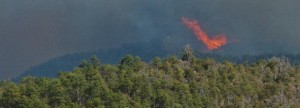
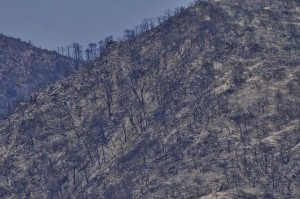
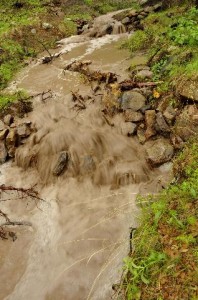
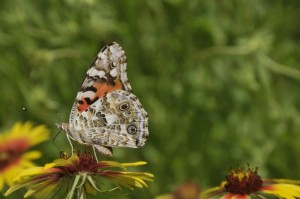
Thanks for the thoughtful exposition, Walt. I believe us to be in a culture that needs to replace consumption and greed with humility and a sense of the common good, a tall order for a short-sighted, often arrogant species.
Diane and I are thankful for the good and visionary work of our friends at Prescott College.
Blessings,
Doug Iverson
Well done, Walt.
I so appreciate your vision, wit and understanding of our world. Thank you for taking the time to share your thoughts.
Juanita Hull-Carlson
Walnut Creek Center for Education and Research